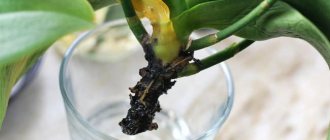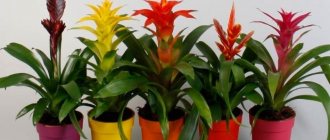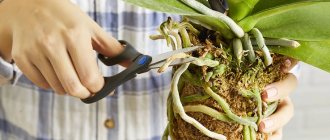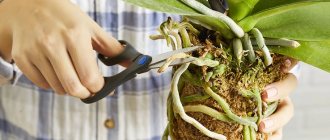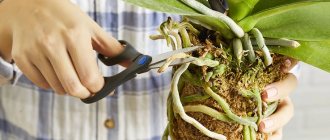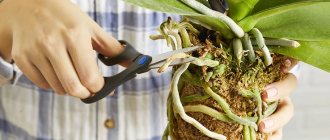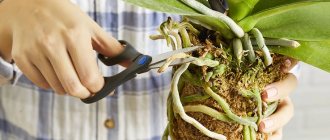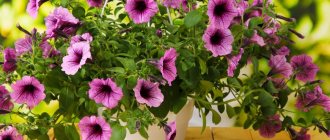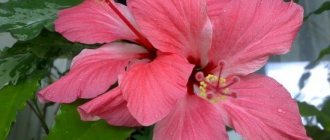Guzmania is an epiphytic plant. In humid tropical climates, the seed germinates on the bark of a dead tree. The roots serve for anchoring; the guzmania receives the necessary nutrition through the leaves, which form a rosette. At home, guzmania is patient in care and replanting, but does not tolerate excessive moisture. The plant loves a bright habitat and frequent spraying. However, droplets of water, like lenses, can cause a burn to the plant if it is exposed to the sun at this time.
How to determine that a flower needs replanting
Unlike other houseplants, guzmania does not need to be replanted regularly - unless, of course, you plan to propagate it. For the flower to feel good, just one change of place of growth will be enough - immediately after purchase, and in the future the slowly developing root system will allow it to continue to be in the existing container.
Important! Most often, stores sell already flowering guzmanias, which means that after about six months the apical part will dry out and the plant will wither, losing all its decorative effect. In order not to be left with nothing, it is better to prepare in advance a sufficient number of children, who will later decorate the home.
When Guzmania reproduces, its babies are transplanted into a separate pot, which appear immediately after the mother bush blooms (begins and ends in the summer). Within 2–4 months after emergence, they form their own root system, so when they reach 15 cm, they are separated from the “mother” and transferred to a separate container.
Growing guzmania from seeds
Guzmania seeds photo
Before sowing, it is good to soak the seeds in a pink solution of potassium permanganate for 10-15 minutes and dry until they flow. The procedure is a prevention of rot and other diseases.
- Scatter Guzmania seeds as little as possible on the surface of the ground and press with your palm.
- The soil for planting seeds consists of a mixture of sand and peat in equal parts.
- After sowing, the soil is sprayed with a spray bottle and the container is covered with a plastic bag.
- Maintain high humidity and temperature within 25 °C.
- Three weeks later you will be able to see the seedlings, you will definitely need to ventilate, and later remove the shelter completely so that the plants do not get sick.
- For about a month, green seedlings will grow and will need to be picked into separate cups. It is better to take larger containers, approximately 7 cm in diameter, to give more space to young seedlings.
In the future, care is similar to care for adult plants. When the plants grow up, they are simply transplanted into permanent pots using the transfer method. After two to three years, flowering can be expected.
When can Guzmania be replanted?
In terms of replanting, guzmania cannot be called a very capricious plant, but, as when growing other indoor flowers, it is advisable to postpone this process to spring, when the root system of the emerging children is fully formed. In the fall, you can replant plants that are in shipping pots, because after purchase they will not be able to develop for a long time in such conditions. In other cases, you should wait to transplant until spring.
How to separate Guzmania babies (video)
When preparing your own soil mixture for growing guzmania, you can mix three parts of leaf soil, one part of pine bark and one part of medium-grained river sand. Before planting the plant, it is necessary to disinfect the soil mixture using high-temperature conditions in the oven.
You should not use too large and voluminous planting containers for transplanting and planting decorative indoor crops. The flower pot must match its size to the relatively small and superficial root system of the guzmania. It is best to purchase a shallow, medium-sized flower pot for growing. The main condition for proper transplantation is the creation of a good drainage layer in the planting container and the presence of high-quality drainage holes. Only in this case will it be possible to prevent stagnation of moisture in the soil and save the ornamental crop from rotting roots.
Preparing for transplant
Preparations in almost all cases involve the same actions: purchasing a suitable pot, preparing the soil substrate and drainage layer. However, in the case of guzmania, an important step will be additional processing of the plant itself.
Choosing a pot
Guzmania is characterized by a shallow root system, which means that the pot for it should be low but wide. Deep containers can lead to rotting of the lower part of the substrate, to which the roots of the flower simply do not grow. The ideal option would be a pot no more than 12 cm high, and the bottom 2-3 cm should be occupied by a drainage layer.
Find out how to properly plant indoor flowers in a pot.
The diameter of the planting container is selected based on the size of the children being planted, but on average it is no more than 10 cm. When transplanting from a transport container of an adult plant, this value can be increased by half, and sometimes more.
Drainage preparation
The height of the drainage layer in a pot with guzmania is usually 1/3 of the total height of the product, and expanded clay, foam plastic or charcoal can be used as a moisture-absorbing material. The latter option is even more preferable, since it is an excellent prevention of high soil acidity and prevents the development of infection, while simultaneously protecting the plant from waterlogging and associated putrefactive processes.
As for the soil mixture, it should be as close as possible to the natural substrate of Guzmania. In nature, the flower often grows not in the ground, but on old wood, so you either plant it in ready-made soil for bromeliad crops, with the addition of peat, sphagnum moss and loose leaf soil, or prepare the soil mixture yourself using one of the following recipes:
- Option 1. A mixture of crushed roots of sphagnum moss and ferns (in a ratio of 1:3).
- Option 2. A mixture of coniferous bark, moss, sand and leaf soil in a ratio of 2:1:1:2.
- Option 3. A mixture of humus, sand, turf soil and peat, in a ratio of 2:1:2:4.
For any of them, it would be appropriate to use crushed charcoal, with the help of which you can increase the looseness of the substrate, even when you are already using it as a drainage layer.
Did you know? In its natural habitat, guzmania can be found in the West Indies, Florida, Venezuela, Brazil and central America. The local population has long considered the flower a symbol of the male gender, believing that being close to men, it is able to maintain their vigor and even prolong their life.
Flower processing
Treatment of guzmania before transplantation is one of the main stages of the preparatory process, and it does not matter for what purpose it is performed. If we are talking about an adult, recently acquired plant, then before placing it in a new pot it would be wise to remove all damaged roots and treat the cut areas with crushed activated carbon, which will subsequently prevent rotting of the root system. The rhizome of children separated from the mother bush can be treated with a growth stimulant, using one of the popular drugs: for example, “Kornevin” or “Heteroauxin”.
Rules for choosing a pot and soil for replanting Guzmania
The soil mixture for growing an ornamental crop of this species must be quite specific, which is due to the characteristics of the growth of Guzmania in natural conditions. In its homeland, this crop uses not soil, but old plant wood for nutrition. In indoor floriculture, guzmania can be planted in ready-made soils intended for growing bromeliads.
The soil sold in flower shops is also perfect for growing orchids. Experienced flower growers and specialists in the field of cultivation of exotic plants recommend adding pine needles, as well as crushed charcoal, to a ready-made soil substrate based on peat, sphagnum moss, pieces of tree bark and loose leaf soil, which will improve the looseness of the soil and also make it as light as possible and optimally suitable for bromeliads.
How to replant a plant at home: step-by-step instructions
Depending on what part of the plant you are going to replant, this process will have certain differences, but in any case you will need the following tools:
- a sharp knife (used to cut off children from the mother bush or remove damaged roots of an adult plant);
- shovel for pouring soil;
- growth stimulator for treating the root system (for example, “Kornevin”);
- landing capacity.
An adult plant can be moved to a new pot using the transfer method, after slightly drying the old soil. There is nothing difficult about this, the main thing is to prepare a suitable soil mixture and a larger pot.
Transplanting children will be more interesting and responsible, so it is advisable to adhere to the following plan of action:
- To begin, remove the mother plant from the pot and carefully remove the root system of the selected Guzmania babies from the old substrate (most often you have to use a knife to separate it).
- Place them on a clean sheet of paper and leave to dry for about an hour. Treat the roots with the prepared solution for better rooting.
- Place a drainage layer in the new pot so that it takes up one third of the total available space.
- Make a small mound of soil and place the root rosette of the plant to be planted in the center.
- Carefully level the roots and sprinkle them with soil substrate, up to the level of the root collar.
- Lightly compact the soil and spray it with settled water from a spray bottle.
Important! There is no need to flood
the plant immediately after transplanting.
In order to absorb moisture well, its roots must first take root in the new environment. At this point, the transplantation of guzmania can be considered complete and all that remains is to move the pot to a suitable place, further providing appropriate care for the rapid rooting of the young flower.
Video: features of development and transplantation of Guzmania
Guzmania transplant technology
As a rule, adult plants die after flowering and do not require replanting, but it is recommended to plant or replant shoots of an ornamental crop very carefully, according to the following technology:
- carefully release the root system of the planted shoot or young ornamental plant;
- lay the extracted plant on a dry surface for about an hour;
- treat the roots of the transplanted crop with a rooting stimulator, which can be “Kornevin” or “Heteroauxin”;
- pour a drainage layer into the flower pot, the volume of which should be approximately a third of the planting capacity;
- fill up a raised area of fertile soil and install a young rosette of a decorative indoor plant;
- very carefully sprinkle the roots of the young plant with a nutritious soil substrate prepared in advance to the level of the root collar of the plant.
Features of care after transplantation
Correctly performed transplantation is only half the battle on the way to obtaining a beautiful and blooming guzmania flower, therefore, so that all the efforts made are not in vain, be sure to take into account several requirements for further care.
Location and optimal conditions of detention
Regardless of the season, the transplanted plant should always be placed in a fairly warm room with moderate lighting and no drafts. However, specific temperature conditions and air humidity in summer and winter will have their differences, so when organizing conditions for the growth and development of Guzmania, you should focus on the following indicators:
| Season | Lighting | Temperature | Humidity |
| Winter | Moderately bright, but without exposure to direct sunlight | +18…20°C | Not lower than 60%, for which it is better to place the flower away from heat sources |
| Spring | +19…+21°C | 65–75% | |
| Summer | Moderate, with protection from direct sunlight in the afternoon | +21…+25°C | 75–80% |
| Autumn | +20…+22°C | 65–75% |
With the arrival of cold weather and the beginning of the use of various heat sources, it is quite difficult to maintain air humidity at the required level, so a pot of guzmania is often placed on a stand with moistened moss or expanded clay laid on it. It will also be beneficial for the plant to place the pot next to an aquarium or a humidifier.
Watering and fertilizers
On the first day after transplanting the flower, it will be enough to thoroughly wet the soil in the pot and add a small amount of liquid to the outlet. In this case, the liquid used must be soft, filtered and relatively warm, for which the water in an open container is left in the room for a day. Hard cold water straight from the tap is detrimental to the plant, especially since in this case the liquid is applied not into the soil, but into the rosette formed by the leaves, filling it to 2/3 of the total volume.
Important! The water remaining in the outlet after watering must be drained or removed with a blotting cloth, otherwise the increased humidity will cause the plant to rot.
.
In summer, it is enough to moisturize guzmania once every two days, and in winter - no more than once a week. Fertilizers for Guzmania are not a vital component of care, since in its natural habitat it receives nutrients in minimal quantities. However, by feeding indoor flowers at home, you can not only stimulate flowering, but also prolong it, which will allow you to admire the plant for 2-3 weeks longer than usual.
To fertilize the exotic beauty, you can use universal compounds developed to enhance the decorative properties of flowering plants (for example, Agricol, Stimovit, Biopon). Before adding to the soil, any of them must be dissolved in water, which will help avoid overfeeding the plant. Moreover, in the case of guzmania, a single dosage should be approximately 4-5 times lower than that recommended by the manufacturer. Treatment of plants with the prepared mixture is carried out from May to September, no more than once a month.
Flower propagation
Propagation of Guzmania can be done in one of two ways: using purchased seed material or by separating the children formed on a dying mother plant. If you purchased an already mature flower, be prepared for the fact that you will soon have to take care of its renewal, because the average lifespan of this plant is 2-3 years, and some specimens die off much earlier.
Did you know? Guzmania and Guzmania are the same plant, and the latter version of the name is even more correct, since the flower was named after the Spanish scientist Guzman. The letter “z” appeared when translating the word “Guzmania” from Latin.
In any case, with proper cultivation, new specimens (“babies”) always grow next to the mother plant, which need to be moved to a separate container. When propagating guzmania by seed, purchased seeds must first be disinfected in a weak solution of potassium permanganate, and then sown in small containers filled with a mixture of peat and sand (in equal proportions).
Germination of seeds is carried out in a warm room, with a stable temperature of at least +25°C and high humidity, which can be achieved by covering the seedlings with oilcloth and regularly spraying the soil with water from a spray bottle. Usually the first sprouts appear after three weeks, and after another 7 days they will need to be picked into separate cups. If all actions are performed correctly, then the emerging seedlings will quickly catch up with the planted children.
Video: Guzmania propagation
Caring for young plants
After replanting, the first watering is plentiful, a lump of earth is soaked and water is poured into the outlet. In this case, the water should be soft, filtered and settled for two days. Watering with hard water is detrimental to Guzmania. It does not require magnesium and calcium salts.
The pot is first placed in a shaded place, after 1-2 weeks it is installed in a permanent place. Shelter at this moment is no longer needed. It is better to replant the plant in the spring, but if necessary, you can at any time. The main thing is to wait for the development of the root system, which could give viability to the plant.
In nature, plants grow in colonies and very densely, creating clumps of plants of all generations. At home, thickening can lead to a lack of flowering. Plants are demanding on the level of illumination. Therefore, it is optimal to plant each guzmania in a separate bowl.
Typical mistakes during transplantation
By paying attention to some important details of transplantation and further care of guzmania, you will be able to avoid many problems.
Check out the houseplant Billbergia.
First of all, we are talking about this:
- Lack of flowering of the plant, which is explained by a lack of moisture, heat or light. To prevent this, children planted in pots should be placed only in a well-lit place, with a suitable temperature and humidity (shown in the table above).
- Rotting of Guzmania immediately after transplantation or during further cultivation. In any case, the main reason for this phenomenon lies in the excessive amount of moisture due to frequent watering and spraying.
- Death of young shoots. If the transplanted plant looks lethargic and soon dies, check the temperature in the room. Typically, such consequences result from prolonged exposure of the flower to temperatures below +12…+13°C.
- Short flowering. The occurrence of this problem is often explained by moisture getting on the opened flower petals, so when watering guzmania during the flowering period, it is advisable to add it to the root.
- Slow growth of the transplanted shoot. Be sure to monitor the quality of water used for irrigation. The slightest admixture of chlorine or low temperature of the liquid will negatively affect development.
- Infection with infectious diseases. If the first signs of the disease became noticeable soon after transplanting the guzmania, then it is likely that it was caused by a violation of sanitary standards when pruning children or when preparing the soil.
- Drying of the transplanted parts. The main reason that plants do not take root in a new place of growth is their lack of a sufficiently developed root system. Simply put, you can separate them from the mother bush only if there are a large number of clearly visible roots.
- Drying leaf tips. Perhaps the indoor air is too dry and young plants need more frequent spraying.
Although these are not all, they are the most common problems with guzmania, so every gardener should know about them. To normalize the condition of a flower, it is enough to review the conditions created for it and make appropriate adjustments. In extreme cases, you will have to replant the plant again without repeating previous mistakes.
Mistakes and ways to avoid them
After transplantation, it is important to monitor the further condition and development of Guzmania. The main errors that occur:
- Slow growth may be due to watering with poor quality water. Use only soft filtered water.
- Rotting occurs when watering too frequently.
- The death of children occurs when the temperature regime is not observed. The optimal temperature is 20-25 degrees.
- Diseases occur when sections are not processed during transplantation.
- Guzmania does not bloom if there is insufficient light in the room and lack of necessary humidity.
- The plant quickly fades if water gets on the petals. It is necessary to water only the soil.
- Guzmania may dry out if the root system was not sufficiently developed at the time of transplantation.
- If there is insufficient humidity, the tips of the leaves may dry out. The plant needs to be sprayed more often and a container of water should be placed nearby.
If you follow these simple rules, you can regularly get young, beautiful and healthy plants when transplanting Guzmania.
Bromeliads, growth characteristics
Guzmania belongs to a very large family of bromeliads, among which there are both ordinary terrestrial plants and so-called “atmospheric” species that grow practically without roots and receive moisture with nutrition literally from the air. And finally, one of the most common groups is the reservoir bromeliads, to which the genus Guzmania belongs.
These unusual plants form such a dense rosette of leaves that it represents a kind of reservoir in which water can accumulate. Guzmanias are epiphytes, that is, they grow in nature on trees, but do not parasitize them. They are usually located on large branches or near the base of the trunk. Their homeland is the moist equatorial forests of South and Central America.
With their large rosette, they collect all the moisture that flows from the leaves of trees, along with numerous particles of organic matter in the form of bird droppings, old leaves, twigs, and buds. Numerous insects can also climb there, for which the outlet can serve as a place of residence and reproduction.
After the flowering period, which can last up to six months, the inflorescence, together with the mother rosette, withers and dies.
Care during the rest period
How to care for decorative guzmania depends on the time of year. There is no clearly defined period of rest; the owner creates it forcibly as daylight hours decrease. During this time, the plant does not require active care and intensive watering.
Watering mode
During the forced dormant period, which lasts from October to February, watering is reduced to once every 2 weeks. The water still needs to be settled, but the pot is not removed from a bright place. If necessary, the crop is provided with artificial lighting for 7-8 hours. Spraying and fertilizing are not used.
Temperature
During the cold season, the temperature can be reduced to 18-20°C. Guzmania can withstand temperatures up to 13°C for a short time, but in such conditions there is a high probability that it will refuse to bloom or send out vegetative shoots.
Types of Guzmania with description and photo
A striking representative of the bromeliad genus, Guzmania has about one hundred and thirty varieties. A whole parade of colorful plants, from which you will have to try to choose the best! Let's look at the most popular types used in indoor floriculture.
Guzmania blood red Guzmania sanguinea
Guzmania blood-red Guzmania sanguinea photo
The bent downward, lanceolate leaves of this plant form a beautiful goblet-shaped rosette. The bracts are bright yellow or red, visible from afar. The exotic is quite large in size: it reaches a height of 20 cm, and the leaf plates reach 5 cm in width and 40 cm in length. The inflorescences are thyroid-shaped, with small flowers up to 12 pieces. Flowering mainly in spring. A striking representative of the species and a common subspecies is Guzmania short-peduncle.
Guzmania musaica
Guzmania mosaic photo
This tropical plant is slightly taller, growing up to half a meter in height. The leaves are up to 80 cm long, they are dotted with frequent transverse stripes of light color against an emerald background. The dense spreading rosette looks very massive. At the base, the leaf blades are painted dark burgundy. The bracts are bright pink, the peduncles are short and erect. The plant blooms in mid-summer with white flowers collected between the yellow sepals of the panicle inflorescence.
Guzmania Donnell-smithii
Guzmania Donnell-smithii photo
Domesticated since the beginning of the 19th century. The leaves of the plant reach 60 cm in length, the height of the beauty is up to 30 cm. Short massive inflorescences no more than 12 cm are quite attractive. Particularly decorative is the rich dark color of the leaves, covered with pale scales. An exotic beauty blooms in spring.
